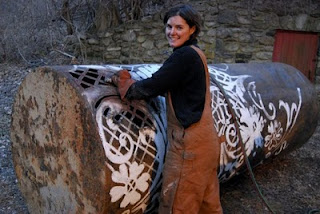Sadegh Tirafkan, Persepolis, 2 x 28.5", 20.5 x 25.2"
An exhibition of more than 60 works of photography and video installations by 20 of Iran’s most celebrated photographers. The exhibition gathers personal perspectives of contemporary Iran filtered through individual sensibilities, while simultaneously addressing public concerns.
Iran has long distinguished itself with the spectacular quality and international presence of its visual art and film. With the backdrop of increasing attention given to the art and culture of Iran and the current political crisis in that part of the world, an exhibition with this focus is most timely. In expressing their many different visions of their world, these artists offer a look at private and public realms. Their perspectives contradict the way many foreign photographers typically capture Iran on film as purely exotic.
Shokoufeh Alidousti offers self-portraits and family photographs exploring cultural and female identity. Esmail Abbasi draws on Persian literature for his subject matter with contemporary notes on the present circumstances in Iran. Shahriar Tavakoli focuses on his family history through a series of portraits capturing the subtleties and mood of the Iranian family. In Koroush Adim’s Revelation series, the images in the exhibition that feature the veil acknowledge this sign of culture, but the “revelation” is anything but simple. Shahrokh Ja’fari’s use of unusual spacial rendering in depicting the veiled figure demands that the viewer look harder and think harder about what can be revealed through the visual.
The images presented in Persian Visions cannot entirely surmount the physical and cultural distance between Iran and the United States. Nevertheless, the exhibition builds a visual bridge that allows for differences, even as it leads viewers to new awareness of other ways of being and seeing.
Persian Visions was developed by Hamid Severi for the Tehran Museum of Contemporary Art in Iran and Gary Hallman of the Regis Center for Art at the University of Minnesota and toured by International Arts & Artists in Washington, D.C. This exhibition is supported in part by grants from the ILEX Foundation; the University of Minnesota McKnight Arts and Humanities Endowment; and the Department of Art and Regis Center for Art at the University of Minnesota.
Exhibition co-curator Gary Hallman, associate professor of art at the University of Minnesota, will give the opening presentation at 6 p.m. Wednesday, Oct. 14. The presentation introduces an overview of the initiation of the project, the staff and director of the Tehran Museum of Contemporary Art, the criteria for the selection of the artists, and a sense of the cultural and political climate that shaped the photographic work and project itself. Selected pieces from the exhibition will provide discussion points illustrating the influences of history, culture and political climate on contemporary practice in Tehran.
Bahman Jalali, Image of Imagination 2, 2003, 28.25 x 28.25"
Mehran Mohajer, T.V. Series 1, 2003, 19 x 51.5"
Arman Stepanian, Untitled, 2001, 27.25 x 38.25"
Koroush Adim, Revelations 1, 19.5 x 29.25"
Ahmad Nateghi, Untitled, 1998, 17.25 x 24"
,+2002.jpg)
Shahriar Tavakoli,
My Family (Hallelujah 2), 2002, 29 x 29"
Via
Haggerty Museum of Art website
















,+2003.jpg)



,+2002.jpg)


































